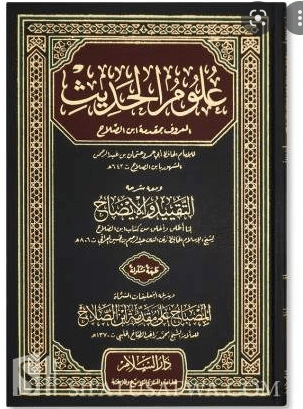
The Muhaddith Imām, the Polymath Shāfi’ī Jurisconsult and Master of the Sciences of the Earlier and Later Generations, Ibn As-Salāh was known as Taqiyuddīn Abū ‘Amr ‘Uthmān. He was the son of the Mufti and Imām Salāhuddīn ‘Abdurrahmān bn ‘Uthman bn Mūsā Al-Kurdī Ash-Shahrazūrī. He was born 577 years after the Hijrah of the Rasūl – salallāhu ‘alayhi wasallam and studied with detail from his Father in the city of Shahrazūr. Thereafter he moved to Mosul where he studied with ‘Ubaydullah bn As-Samīn, Nasr bn Salāmata Al-Haytī, Abī Al-Mudhaffar and many others. He also studied from the Imāms and frontliners of Ilm in Baghdād and Naysābur.
Of them were women the likes of Zaynab bint Abī Al-Qāsim Ash-Shi’iriyyah – rahimahullāh.
He also travelled to Dimashq where he studied from the two foremost Imams of Fiqh and Hadīth: Fakhruddīn Ibn ‘Asākir and Imam Ibn Qudāmah Muwaffaquddīn the author of Al-Mughnī.
He was known as the Imām of Hadith and a Mufti, a Polymath in Fiqh as he was the Ustādh of Al-Ashrafiyyah.
Ibn Al-Hājib said about him in his Mu’ujam:
“He was an Imām, Pious, gifted with abundance of Intellect and understanding, excellent of Character, adept in Usūl and Furū’, he was very dedicated to Knowledge Seeking to the extent that he became synonymous with it. He exerted his utmost in Obedience to Allāh and in Ibādah.”
He was foremost in the Science of Hadīth and he was the pivot upon which relied all of the Imāms of Hadith after him.
It is mentioned that the book Ulūmu Al-Hadīth was a dictation of his which was attended by his students who later compiled and transmitted it.
About this book, Ibn Hajar said:
“Until the coming of Al-Hāfidh Al-Faqīh Taqiyuddīn Abū ‘Amr ‘Uthmān bn As-Salāh bn ‘Abdirrahmān Ash-Shahrazūrī the resident of Dimashq. He compiled his renown book when he took charge of teaching Hadīth in the Ashrafiyyah Madrasah where he purified it’s sciences and dictated it piecemeal and for this reason it is not organized in it’s proper order. He took special care to putting together and expounding on the diverse corpuses of Al-Khatīb (Al-Baghdādī) and added much to it of benefits and necessities. Thereby his book contained and encompassed so much that were scattered in other than it and for this reason, the entirety of the People (of Hadīth) pitched their tents on it and threaded his path. It can’t then be counted, how many a people composed it into Poetrical lines and summarized it, made editions of it and endorsements, and rejoined some positions in it and strengthened…”
This that was said by Ibn Hajar is the truth for almost all the Books of the Science of Hadith today rely on the Ulumu Al-Hadīth by this great Imām.
Of the foremost of it’s commentaries are Ibn Hajar’s An-Nukat, and Al-‘Irāqī’s At-Taqyīdu Wa Al-Īdāh Limā Ughliqa Wa ‘Utliqa Min Kitābi Ibn As-Salāh
Of the Summary that has been authored on the book are Irshādu Tālibu Al-Haqā’iq by An-Nawawī (from which he later wrote the Taqrīb) and Ibn Jamā’a’s Al-Minhalu Ar-Rawiyy
Of the famous Mandhūmāt that have been written in it’s regard are the Alfiyyah of Al-‘Irāqī and Ibn Khalīl’s Aqsā Al-Amal
May Allāh be merciful unto Imām Ibn As-Salāh and unite us with him in the Firdaws in the company of the Messengers, the Siddīqīn, the Shuhadāh and the Pious, amīn
Bārakallāhu Fīkum
Jazakumullāhu Khayran



